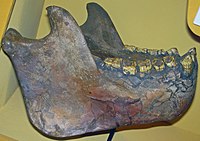
Photo from wikipedia
Molar morphology plays a key role in the systematics and behavioral interpretation of fossil taxa, so understanding the developmental patterns that shape occlusal morphology in modern taxa is of central… Click to show full abstract
Molar morphology plays a key role in the systematics and behavioral interpretation of fossil taxa, so understanding the developmental patterns that shape occlusal morphology in modern taxa is of central importance to informing analysis of the fossil record. The shape of the outer enamel surface (OES) of a tooth is largely the result of the forming and folding of the inner enamel epithelium, which is preserved in fully formed teeth as the enamel-dentine junction (EDJ). Previous research on living primates has shown that the degree of correlation between the EDJ and OES can be used to inform our understanding of developmental patterns because lower correlations imply that later developmental events modify the template provided by the EDJ more extensively. Here, we use three topographic metrics to investigate the degree of correlation between the EDJ and OES across living euarchontans by analyzing treeshrews and dermopterans in addition to primates. We found that all living euarchontans show a high degree of topographical correlation, whereas non-primates, especially basally divergent taxa such as Ptilocercus lowii, show the highest degree of correlation between these two surfaces. Our results indicate, that while it is the earlier stages of dental development that have the most influence on overall crown morphology in euarchontans generally, among primates, anthropoids have a lower degree of correlation, implying a greater emphasis on later phases of dental development. This provides insight relevant to interpreting the evolutionary context of the diversity of dental form observed within Euarchonta.
Journal Title: Journal of Mammalian Evolution
Year Published: 2018
Link to full text (if available)
Share on Social Media: Sign Up to like & get
recommendations!